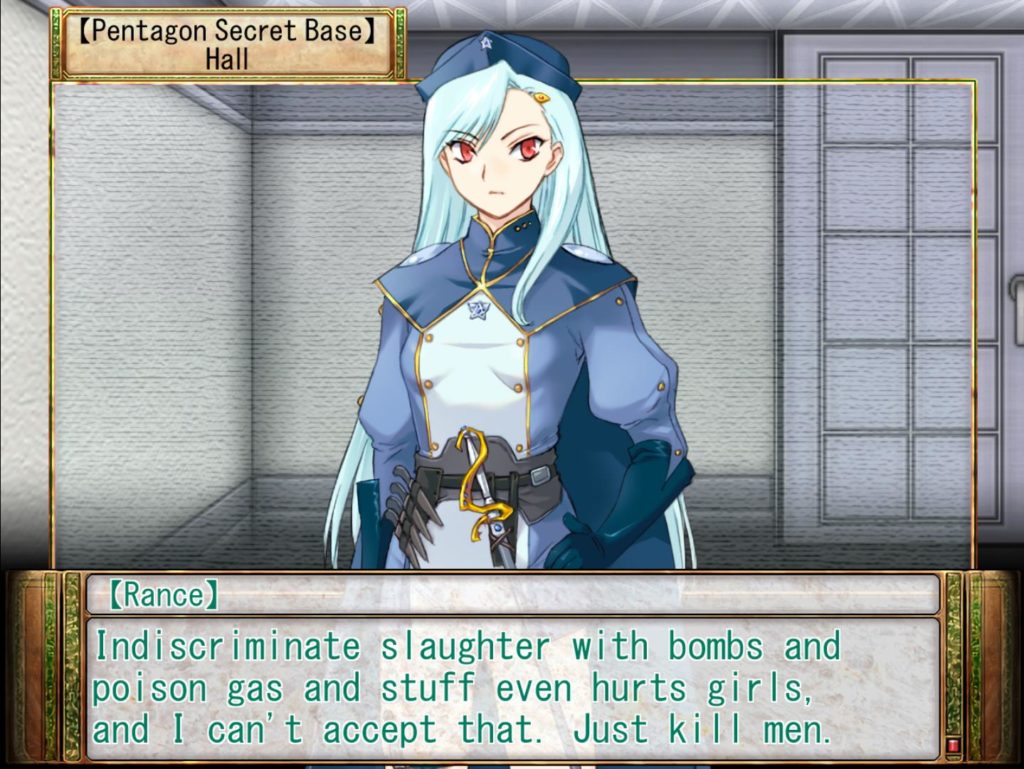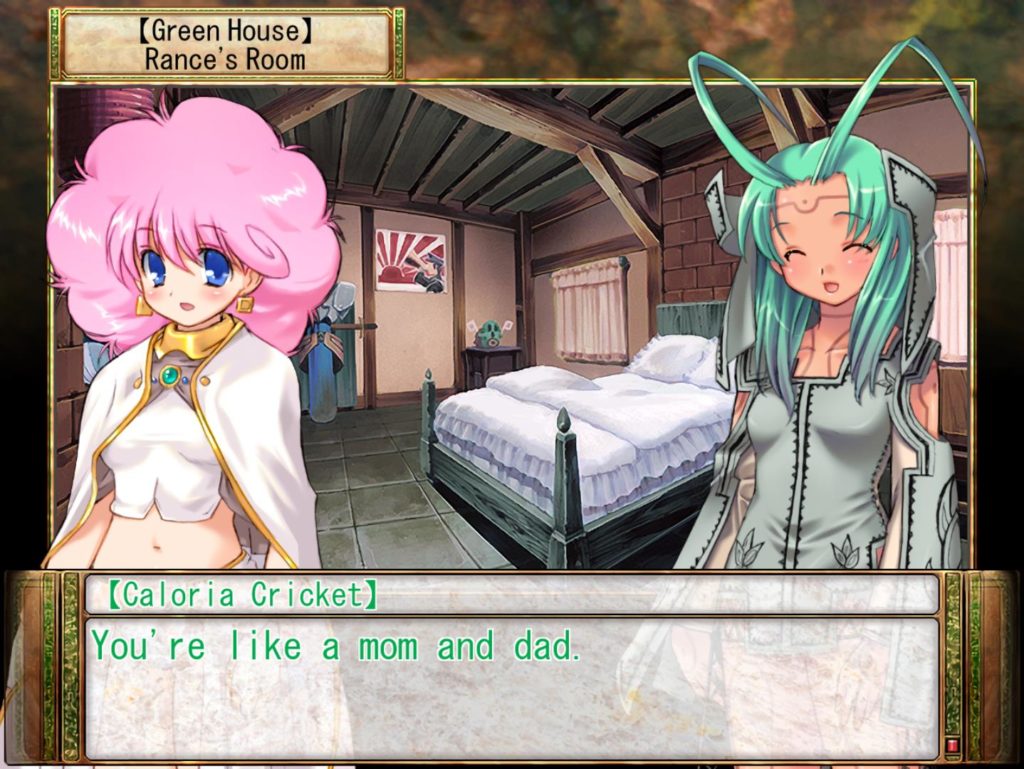The History of Lewd: Rance VI – Collapse of Zeth
Rance 5D: The Lonely Girl, first of the series to be localised by MangaGamer, was my introduction to the Rance series. Rance VI: Collapse of Zeth was the game that made me understand why it was such an incredibly special series. And, perhaps more importantly, how and why it had managed to endure for so long, even with many people still operating on the assumption that it’s little more than a series of porn games with a worrying emphasis on sexual assault.
Rance VI is an epic. An epic for adults. An epic which understands that stories come in all shapes and sizes, and that larger, sweeping narratives are best supported by smaller-scale, seemingly innocuous tales that eventually come together to give us a complete picture of what is going on. And an epic which, despite obviously being developed on a tight budget — remember, Rance 5D was a bit of a last-ditch effort to “save” the series, so doubtless developer Alicesoft felt they were still on slightly shaky ground — manages to tell a fascinating, compelling, thrilling story.
It’s a game that knows when to make you laugh, when to make you cry, when to make you sickened at the things you’re witnessing unfold, and when to inspire you on to great things. It is, in short, a Good Thing.

Rance VI first came out in 2004 in Japan; it would be 2016 before we got to see it in the west, however, when it was released in a double-pack with Rance 5D by MangaGamer. It tells the story of inequality and oppression in the land of Zeth, one of the many countries that make up Rance’s setting of “The Continent”.
Rance inadvertently finds himself in the middle of this civil unrest when he is accidentally sold into slavery after a Zethian mage misunderstood his relationship with his perpetual companion (technically slave) Sill Plain, who is a mage. He eventually finds himself signing up with a resistance group called Ice Flame, though not entirely out of the goodness of his heart — not only does he see helping the resistance as a great opportunity to get his own back on the mage who wronged him, but also a great means of getting to sleep with a bevy of beautiful women.
One interesting aspect of Rance VI’s storytelling comes from the fact that it is an 18+ game, and therefore has no reason to hold back from showing absolute atrocities being perpetrated in the name of Zeth’s oppressive societal hierarchy. Whereas many role-playing games that explore such themes tend to simply imply terrible things are taking place, there are numerous instances in Rance VI where it feels like the game is forcing your eyes open and making you watch as horrible things are unfolding. And yes, these horrible things are often sexual in nature.

Juxtaposing this aspect of the narrative with Rance’s morally questionable nature makes for some intriguing character development. While Rance is the “hero” of the story (though, if we’re getting deeper into Rance lore, technically not actually a capital-H Hero), he’s not above doing some morally reprehensible things to get his jollies. He rapes a female adventurer within the first five minutes of the game and has a habit of humiliating defeated female foes in the same way; rather peculiarly, though, a lot of people around him seem to just sort of shrug this behaviour off.
The reason for this is that in the context of Rance’s world as a whole — particularly Zeth, where some seriously nasty shit goes down on a fairly regular basis — Rance’s behaviour is, relatively speaking “not that bad”. By the standards of our society, yes, of course, he would be locked up and the key thrown away — but there’s an obvious and marked difference between the way Rance treats his victims and those who suffer at the hands of the game’s antagonists.
Notably, Rance doesn’t do what he does indiscriminately, out of maliciousness or out of a desire to actually hurt people, whereas we see that the villains of the piece in Rance VI often inflict sexual humiliation on others purely to see them suffer — not to derive any sort of sexual gratification themselves.

Rance has standards; he only pursues partners (or victims) he regards as “beautiful” and who he believes to be on a similar level to him in society; he’ll always attempt to seduce them first rather than jumping immediately to assaulting them — and even then there are occasions when he decides he should just cut his losses and value his friendship with the girl in question over his desire to have sex with her.
There’s a marked difference in tone between Rance’s sex scenes and the “sexual horror” scenes throughout the game’s runtime; as paradoxical and inappropriate as it might sound, Rance has a certain degree of “consideration” for his victims, taking care to pleasure them even if he has forced himself on them.
Contrast these scenes: one where Rance challenges a defeated Fiend to bring him to orgasm before he does the same to her, and another elsewhere in the game where we witness a group of mages gangraping a character who began as an antagonistic figure and who subsequently becomes a reluctant ally. The former scene has uncomfortable elements, sure, but there are also aspects of humour, eroticism and vulnerability; the latter, meanwhile, is nothing but violence and brutality, made all the more heartbreaking by the victim of the scene just picking herself up afterwards, clearly accustomed to such treatment.
Of particular note throughout Rance VI are the scenes between him and some of the series’ recurring characters, such as Rizna Lanfbit (who was the titular “Lonely Girl”, rescued in Rance 5D) and Shizuka Masou, who has been around since the earliest days of the series.

In Rizna’s case, she and Rance eventually manage to develop a relationship based on mutual trust; Rance recognises that Rizna is uncomfortable with her body which was trained to be highly sensitive to stimulation as a sex slave and treats her accordingly gently — for the most part, anyway. By the end of Rance VI, the pair have one of the most genuine-seeming friendships in the whole series; it’s really quite touching to see.
Shizuka, meanwhile, finally sees a narrative thread that kicked off in the second Rance game coming to a head in Rance VI, and this is a significant, powerful moment, particularly for longstanding followers of the series. Rance recognises that there are things more important than sleeping with Shizuka while all this is going on — and it’s through helping her finally resolve this situation that means so much to her that he is at his most heroic.
But there is so much more that can be talked about with regard to Rance VI’s story and characters, and not nearly enough time to do so. So before we wrap up today, let’s also acknowledge another great thing about the game: its overall mechanics and structure.

At heart, Rance VI is a dungeon crawler, but there are some notable differences between it and something like, say, Dungeon Travelers 2. Chief among these is the fact that the dungeons are designed less as “mazes” and more as abstract approximations of realistic locations. Yes, they still use tile-based movement and 90-degree corners, but something about the overall map designs stokes the fires of the imagination and really helps you feel like you’re in “real” places rather than simple “dungeons”.
Probably the most interesting mechanical element is Rance VI’s stamina system. Here, each character has between 4 and 12 stamina points, and each battle they participate in drains a single one of those points. When they’re run dry, they can’t fight any more until you return to base and rest — and stamina doesn’t increase with level. This means that in order to successfully progress through most dungeons, you’ll need to rotate your playable cast members around and ensure you have several optimal formations available.
Alongside this, there are rewards available for staying in a dungeon for a long time without retreating back to base, as well as experience bonuses for not just taking your most powerful characters into battle all the time. Up to 16 characters in your “squad” can be taken along on an expedition, but only six fight at once; you can also manipulate the experience gain rate by bringing along people who have hit their level cap, since they are effectively removed from the equation when determining bonuses.

Oh, and there are friendship mechanics, too. You can raise these through optional repeatable events or giving gifts to characters, and at various friendship milestones you can permanently improve the characters in various ways. On top of that, if you can convince the playable ladies of the cast to jump into bed with Rance, the mysterious powers of his semen can raise their level cap; naturally, since Rance doesn’t “do” guys, this means once the few male members of the party hit their cap, that’s as far as they go — though don’t make the mistake of thinking this doesn’t mean they’ll be useful any longer!
As you can hopefully see from all this, Rance VI: Collapse of Zeth is a complex and fascinating game, both from a narrative and a mechanical perspective. It’s a genuinely good game — and its more morally questionable aspects make for some intriguing food for thought at times rather than simply being titillation.
It is, in short, a perfect example of what the Rance series really is — and so, if you have an open enough mind, I’d encourage you to give both it and its immediate predecessor a go. You can find out more about the series as a whole — and order the installments that have been localised to date, which include Rance 01 and 02, Rance 5D and VI, Sengoku Rance (VII) and Rance Quest Magnum (VII) — via our friends at MangaGamer.
Join The Discussion
Rice Digital Discord
Rice Digital Twitter
Rice Digital Facebook
Or write us a letter for the Rice Digital Friday Letters Page by clicking here!
Disclosure: Some links in this article may be affiliate links, which means we may earn a small commission if you make a purchase after clicking on them. This is at no additional cost to you and helps support Rice Digital!
- Letter from the Editor: passing the torch - June 30, 2023
- Super Woden GP 2 is looking promising - June 30, 2023
- Inti Creates is making a 32 bit-style Love Live action platformer - June 26, 2023







